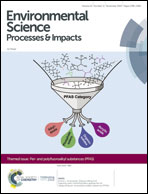Investigation of binding and activity of perfluoroalkyl substances to the human peroxisome proliferator-activated receptor β/δ†
Abstract
Previously, perfluoroalkyl substances (PFASs) have been found to be associated with many adverse effects mediated by the peroxisome proliferator-activated receptor α (PPARα) and PPARγ. Here, we found another subtype of the peroxisome proliferator-activated receptors (PPARs); the PPARβ/δ mediated pathway might also be a potential adverse outcome pathway for PFASs. We investigated the direct binding and transcriptional activity of PFASs toward human PPARβ/δ, and further revealed the structure-binding and structure–activity relationship between PFASs and PPARβ/δ. The receptor binding experiment showed that their binding potency was dependent on the carbon chain length and the terminal functional group. For twelve perfluoroalkyl carboxylic acids (PFCAs), an inverted U-shaped relationship existed between the PPARβ/δ binding potency and the carbon chain length, with perfluorododecanoc acid (C12) showing the highest binding potency. The three perfluoroalkane sulfonic acids (PFSAs) exhibited a stronger binding potency than their PFCA counterparts. The two fluorotelomer alcohols (FTOHs) showed no binding potency. In receptor transcriptional activity assays, they enhanced the PPARβ/δ transcriptional activity. Their transcriptional activity was also related to the carbon chain length and the terminal functional group. Molecular docking analysis showed the PFASs fitted into the ligand binding pocket of PPARβ/δ with a binding geometry similar to a fatty acid.

- This article is part of the themed collection: PFAS


 Please wait while we load your content...
Please wait while we load your content...